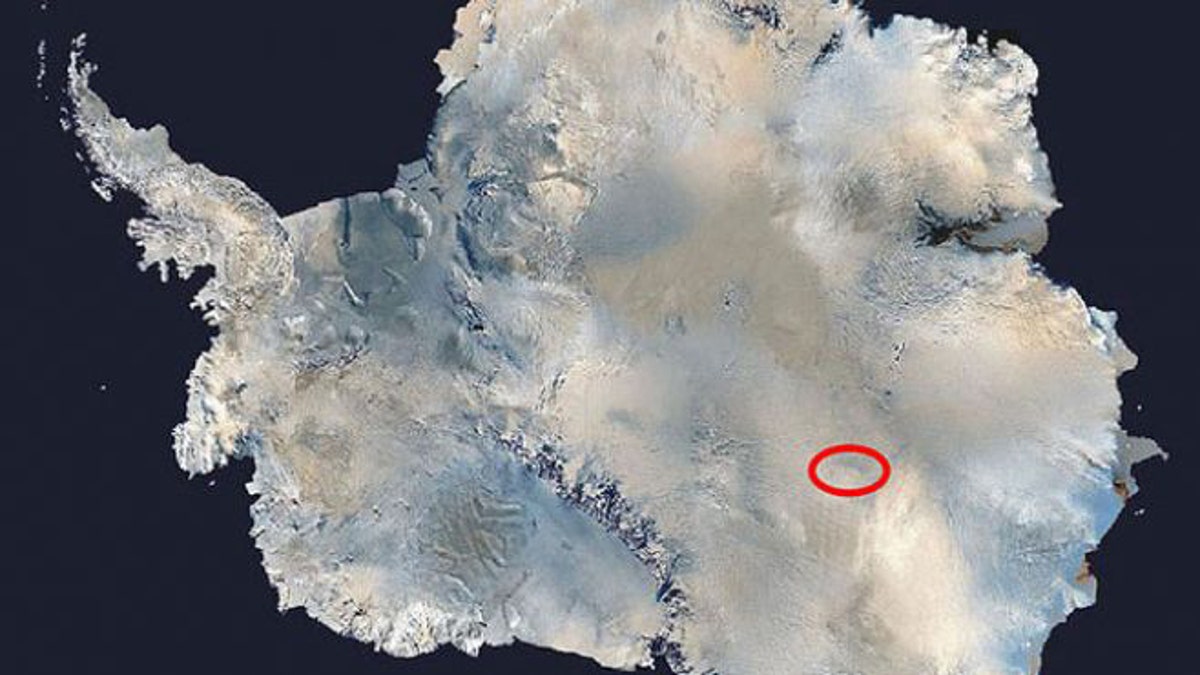
NASA photo of Lake Vostok in Antarctica. (NASA)
Microbes that live inside fish intestines are among the array of life that appear to have been found in ice drilled from above Lake Vostok, the deepest lake buried beneath Antarctica's ice sheet.
The ice is thought to be from frozen Vostok lake water, chilled by contact with the lake's overlying glacier. Called accretion ice, scientists first reported evidence of microbes in this ice in the journal Science in 1999. In some spots above the lake, the accretion ice is more than 650 feet thick and 20,000 years old, scientists believe. Though ice has sealed the surface for up to 15 million years, subglacial waterways may have refreshed the lake and even brought in life from outside the basin, scientists think.
Now, a new study of genetic material in the accretion ice reveals more than 3,500 unique traces of life in Lake Vostok, including animals, from a wide variety of ecosystems. Most of the snippets of DNA and RNA are from bacteria and fungi, according to the report, published July 3 in the journal PLOS ONE. Some sequences match living microbes pulled from the same ice cores by the research team in 2008 and 2009, said senior author Scott Rogers, a molecular biologist at Bowling Green State University in Ohio. [Strangest Places Where Life Is Found on Earth]
Although the researchers found genetic evidence of many different organisms in the ice, the overall concentration was incredibly low compared with water from lake systems on other continents, Rogers said, ranging between one cell to 100 cells per milliliter of fluid. "If [Lake Vostok] does have life, it's interesting life, but it's not highly concentrated life," Rogers told LiveScience.
New view of Vostok
Lake Vostok is Antarctica's biggest and deepest subglacial lake; its surface sits 1,600 feet below sea level. It is roughly the size of Lake Ontario and lies beneath 2 miles of ice. The lake basin is about 35 million years old and was entombed after Antarctica underwent a deep freeze about 15 million years ago. Signs of subglacial waterways suggest rivers, streams or floods periodically refresh the lake, so the water in the lake is much younger than 15 million years. However, Rogers estimates the accretion ice tested in the study is between 5,000 to 10,000 years old.
The ice cores analyzed in the current study have been shared and scrutinized internationally since they were extracted in the 1990s by Russian scientists. The first hints of life turned up soon after the cores were removed, such as in the series of papers published in Science in 1999.
In their new study, Rogers and his colleagues discovered genetic sequences from cold-loving extremophiles, adapted to the chilly, light-poor environment. Among the bacteria were species that live in hydrothermal vents and organisms that colonize the intestines of rainbow trout, lobsters and tubeworms.
The team also found stretches of RNA and DNA from animals such as tiny, deep-sea-living mollusks and the water flea, a small floating crustacean found in almost every permanent water body on Earth. "The organisms we've been finding are in the very, very small range. These are tiny little creatures," Rogers said.
Finding Vostok's hotspot
Reports of life from Antarctic lakes, especially from the Vostok ice cores, have been plagued by problems with contamination. In the past decade, Rogers and his team developed a painstaking decontamination technique to remove genetic contagion on the outside of the ice core while preserving the ancient DNA and RNA within, he said. The method involves a bleach wash, as well as melting, filtering and refreezing the ice.
"Contamination is still a concern, but we think the contamination methods we have developed ensure that all the external contamination has been eliminated," Rogers said.
In the future, the team plans to conduct genetic tests on additional ice cores to pin down the center of biological activity above the lake. Studies suggest the shallow part of the lake is the active zone, with the highest cell counts in ice cores from above this region, Rogers said.
"As you get further out into the lake, the cell count really drops," he said. "We're interested in finding out what's there and how they're able to live there. Life seems to find a way to survive almost everywhere on Earth that you can go."
Earlier this year, scientists exploring subglacial Lake Whillans reported the first evidence for microbial life in water retrieved from a buried lake in Antarctica. There are nearly 380 subglacial lakes, remnants of the lost world beneath the ice sheet.
